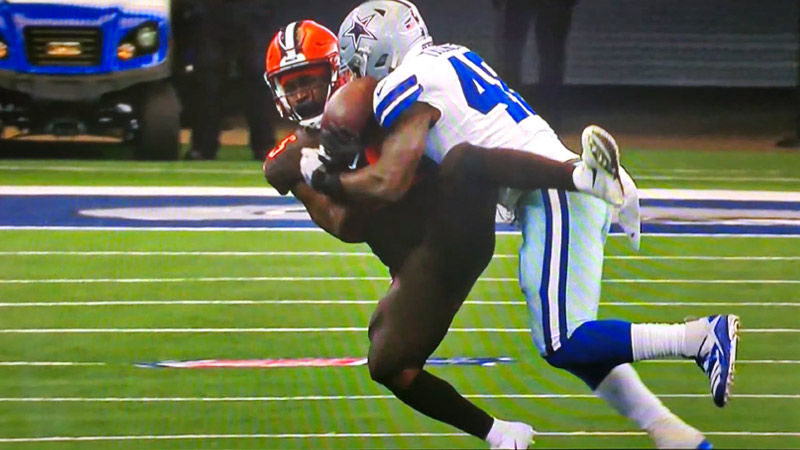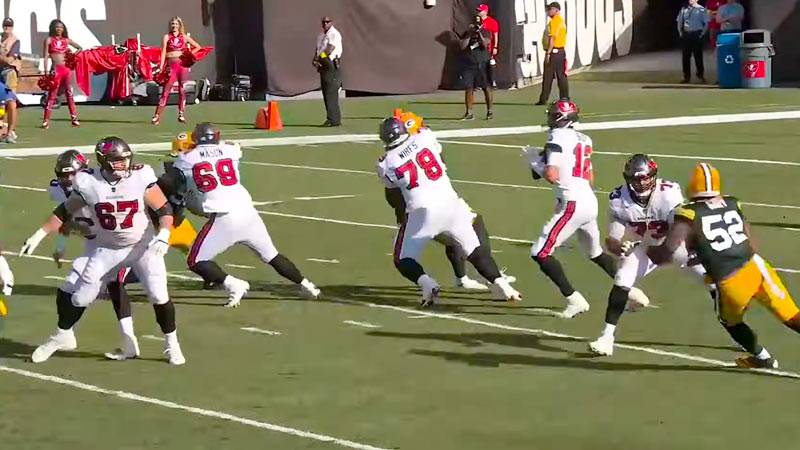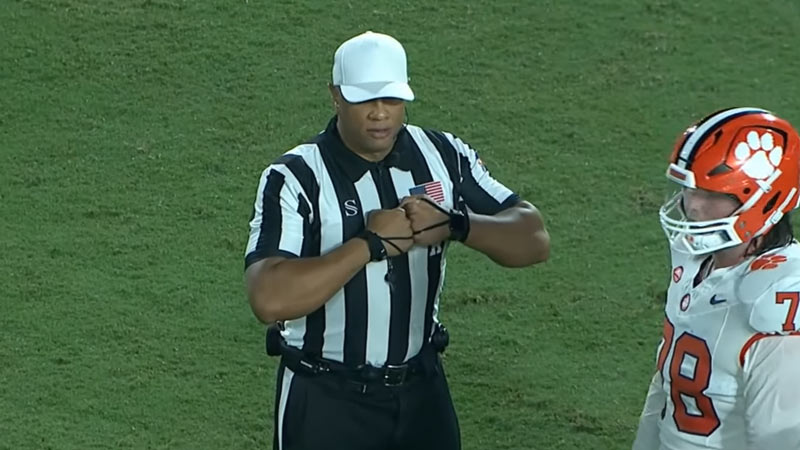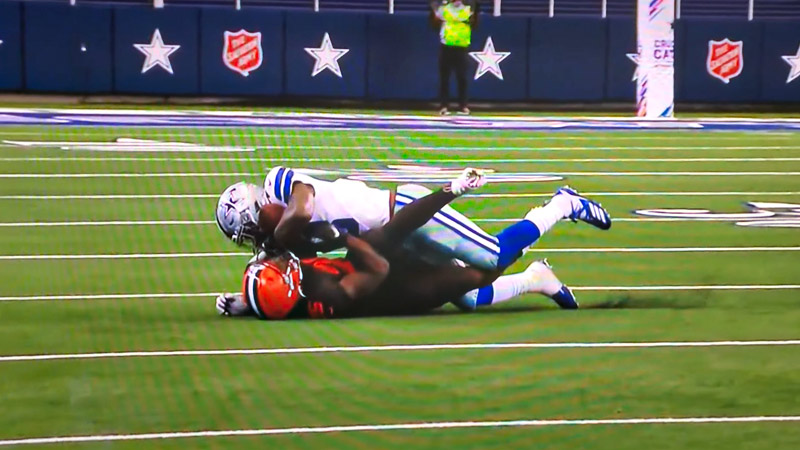In the fast-paced and hard-hitting world of American football, player safety is a paramount concern. As the sport continues to evolve, so do the rules aimed at protecting athletes from unnecessary and dangerous hits.
One such rule that underscores this commitment to player well-being is the “Defenseless Player Penalty.”
In this blog post, we delve into the intricacies of this penalty, its significance, and its role in shaping the game we know and love today. So, get ready and stay concentrated.
What Is Football Defenseless Player Penalty?
In the National Football League (NFL), a defenseless player penalty is a rule designed to protect players from unnecessary and dangerous hits that could cause injury. A defenseless player is typically one who is not in a position to defend themselves due to their actions or the nature of the play.
This penalty is called when a defensive player delivers a hit to an opponent who is considered defenseless at the time of contact, such as a receiver attempting to catch a pass or a player already wrapped up by other defenders.
The penalty results in a 15-yard yardage loss for the defensive team and an automatic first down for the offensive team. The rule aims to prioritize player safety and reduce the risk of severe injuries during games.
How Does a Defenseless Player Penalty Happen?

A defenseless player penalty in the NFL occurs when a defensive player makes contact with an opponent who is considered defenseless at the time of the hit.
The league has defined specific situations in which a player is considered defenseless to prevent unnecessary and dangerous hits. These situations include:
Receiver in Mid-Air
A receiver is in the act of catching a pass and has not yet had the opportunity to defend themselves or establish their position as a runner.
Blindside Blocks
Hits dare delivered to an opponent from the blindside, where the player cannot see the impending hit coming.
Quarterback in Passing Posture
Quarterbacks in the process of passing the ball are considered defenseless until they become runners.
Kick/Punt Returners
Returners attempting to catch a punt or kickoff are defenseless until they establish themselves as runners.
Player Wrapped Up
An opponent who is already being tackled and unable to protect themselves is considered defenseless.
Sliding Quarterbacks
Quarterbacks sliding feet-first to end a play are considered defenseless, and hits on them can result in a penalty.
Helmet-to-Helmet Contact
Hits targeting the opponent’s head, especially helmet-to-helmet contact, can result in a defenseless player penalty if the hit is deemed avoidable and excessive.
A defenseless player penalty is called by the officials on the field when they determine that the defensive player’s hit was unnecessary, avoidable, and posed a risk of injury to the defenseless player.
The penalty results in a 15-yard yardage loss for the defensive team and an automatic first down for the offensive team, promoting player safety and discouraging dangerous hits during the game.
Consequences of Defenseless Player Penalty

The consequences of a defenseless player penalty in the NFL are as follows:
Yardage Loss
The defensive team is penalized with a loss of 15 yards from the spot of the foul. This can significantly impact field position and potentially give the offensive team a significant advantage.
Automatic First Down
In addition to the yardage loss, the offensive team is awarded an automatic first down. This means that even if they were short of the necessary yardage for a first down before the penalty, they now receive a fresh set of downs to continue their offensive drive.
Clock Stoppage
The game clock is typically stopped when a penalty is called, allowing both teams time to regroup and adjust their strategies.
Player Safety Emphasis
The primary purpose of the defenseless player penalty is to prioritize player safety by discouraging dangerous hits and actions that could lead to injuries. By penalizing defenders for targeting defenseless players, the NFL aims to reduce the risk of serious harm on the field.
Discouraging Unsportsmanlike Behavior
The penalty serves as a deterrent against players engaging in reckless or unsportsmanlike behavior that puts their opponents at risk. It encourages players to make safe and controlled plays while tackling or engaging with opponents.
Influence on Game Momentum
Like any penalty, a defenseless player penalty can impact the flow and momentum of a game. It can shift the advantage from the defensive team to the offensive team, potentially leading to changes in scoring or game outcomes.
Referee Discretion
The officials on the field have the responsibility of determining whether a hit qualifies as a defenseless player penalty. Their judgment can vary, and not all instances of contact with a defenseless player result in penalties.
Football Defenseless Player Penalty Signals
In American football, officials use specific signals to indicate a defenseless player penalty. When a defensive player commits a foul against a defenseless player, the referee and other officials on the field use hand signals to communicate the penalty to players, coaches, and fans.
The signal for a defenseless player penalty involves raising one arm horizontally while making a fist and then bringing the arm down to the side. Here’s a breakdown of the signal:
Raise Arm Horizontally

The official raises one arm straight out to the side, parallel to the ground.
Make a Fist
While the arm is extended, the official forms a fist with the hand.
Bring Arm Down
The official then brings the arm down to their side, completing the signal.
This signal signifies the defenseless player penalty and indicates that a player has been hit in a manner that violates the rules designed to protect defenseless players.
Significance of Defenseless Player Penalty
The defenseless player penalty in American football holds significant importance for several reasons:
Player Safety
The primary objective of the defenseless player penalty is to prioritize player safety. By penalizing hits on defenseless players, the penalty aims to reduce the risk of serious injuries, particularly head and neck injuries, which can have long-term consequences for players’ health and careers.
Preventing Unnecessary Hits
The penalty discourages players from making unnecessary and dangerous hits on opponents who are in vulnerable positions. This helps promote a culture of responsible and safe gameplay, fostering a safer environment for all players on the field.
Promoting Fair Play
The defenseless player penalty reinforces the importance of fair play and sportsmanship. It encourages players to compete within the boundaries of the rules and to avoid engaging in actions that could harm opponents needlessly.
Game Integrity
Ensuring that the game is played safely and fairly contributes to maintaining the integrity of the sport. Fans, players, and stakeholders expect a level playing field where rules are enforced consistently.
Strategic Impact
The penalty can have a significant impact on the outcome of games. It can alter field position, extend offensive drives, and potentially influence scoring opportunities, making it a critical factor in-game strategy and momentum.
League’s Image
By taking player safety seriously and penalizing actions that endanger players, the league presents itself as responsible and caring about the welfare of its athletes. This positive image can attract fans, sponsors, and support from various stakeholders.
Evolution of the Sport
The introduction and enforcement of penalties like the defenseless player penalty demonstrate the sport’s commitment to evolving and adapting to modern concerns.
As knowledge about the long-term effects of head injuries grows, rules like these reflect football’s efforts to address those concerns proactively.
Educational Opportunity
The defenseless player penalty serves as an educational tool for players, coaches, and fans. It raises awareness about the types of hits that are considered unsafe and encourages a better understanding of how to engage in the sport while minimizing risks.
Penalties That Are Similar to Defenseless Player Penalty
Several penalties in American football are similar in nature to the defenseless player penalty in that they focus on player safety, unnecessary hits, or unsportsmanlike behavior. Some of these penalties include:
Unnecessary Roughness
This penalty is called when a player uses excessive force or engages in rough and unnecessary contact against an opponent. It encompasses actions that are not considered part of normal gameplay and could lead to injury.
Targeting
Targeting penalties are called when a player intentionally hits an opponent above the shoulders with the crown of their helmet. This penalty aims to prevent helmet-to-helmet hits that can cause head and neck injuries.
Late Hit
A late hit penalty is assessed when a defensive player makes a hit on an opponent after the play is over or after the ball is clearly out of the player’s possession. This penalty prevents unnecessary hits that can lead to injuries and often includes a defenseless player situation.
Hitting a Defenseless Player
This is a broader term that encompasses hits on players who are in vulnerable positions, similar to the defenseless player penalty. It includes instances where a player is engaged in an act that makes them unable to protect themselves, such as catching a pass or already being tackled.
Roughing the Passer
This penalty is called when a defensive player makes illegal contact with the quarterback after the ball has been thrown. It aims to protect quarterbacks, who are particularly vulnerable during passing plays.
Horse-Collar Tackle
This penalty is assessed when a defender tackles an opponent by grabbing the inside collar of their shoulder pads or jersey and yanking them backward. The penalty aims to prevent injuries that can occur when players are forcefully pulled down by their collars.
Face Mask
A face mask penalty is called when a player grabs or twists the face mask of an opponent’s helmet. This penalty prevents dangerous actions that can cause neck and head injuries.
Personal Foul
This is a general category of penalties that includes actions that are considered unsportsmanlike conduct, endangering opponents, or violating the principles of fair play. Many defenseless player situations can lead to personal foul penalties.
These penalties collectively emphasize player safety, discourage dangerous plays, and promote a culture of respect and sportsmanship on the football field.
FAQs
What is a Defenseless Player Penalty?
The Defenseless Player Penalty is a rule within the National Football League (NFL) that safeguards players from hits that could lead to serious injuries.
It’s called when a defensive player makes contact with an opponent who is in a vulnerable position, such as a receiver attempting to catch a pass or a player already wrapped up by defenders. This penalty enforces responsible play and reduces the risk of player harm.
When is a Player Considered Defenseless?
A player is considered defenseless when they are in a position where they cannot protect themselves from a hit due to their actions or the nature of the play.
This includes instances like a receiver in mid-air attempting to catch a pass, a punt returner waiting to field the ball, or a quarterback in the process of passing.
What are the Consequences of the Penalty?
When a Defenseless Player Penalty is called, the defensive team is penalized with a loss of 15 yards from the spot of the foul. Additionally, the offensive team is awarded an automatic first down. These consequences have a tangible impact on field position and the momentum of the game.
How Does the Penalty Promote Player Safety?
The penalty serves as a deterrent against reckless and dangerous hits that could lead to concussions, head, and neck injuries. By penalizing players for targeting defenseless opponents, the NFL encourages safer tackling techniques and responsible gameplay, contributing to the overall safety of athletes.
How Has the Penalty Impacted the Game?
The Defenseless Player Penalty has significantly influenced the game by fostering a culture of safety and respect on the field. It has encouraged players to adopt more controlled and mindful approaches to tackling and engaging with opponents, ultimately reducing the occurrence of severe injuries.
Wrapping Up
As the NFL continues its commitment to player safety and the evolution of the sport, the Defenseless Player Penalty stands as a testament to these values.
By penalizing actions that jeopardize player well-being, the league has taken strides to create a safer and more responsible playing environment.
This penalty not only influences gameplay dynamics but also underscores the importance of preserving the integrity of the sport while safeguarding the athletes who make it all possible. Best of luck.







